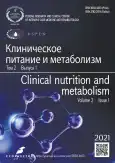Screening methods for the nutritional status assessment in young children with an intestinal infection
- 作者: Erpuleva Y.V.1, Rumiantsev R.E.1,2
-
隶属关系:
- Сhildren’s City Clinical Hospital № 9 named after G.N. Speransky
- The First Sechenov Moscow State Medical University (Sechenov University)
- 期: 卷 2, 编号 1 (2021)
- 页面: 37-43
- 栏目: Reviews
- URL: https://journals.rcsi.science/2658-4433/article/view/81078
- DOI: https://doi.org/10.17816/clinutr81078
- ID: 81078
如何引用文章
全文:
详细
The nutritional status assessment in young children with infectious diseases is an important and necessary measure in the practice of a pediatrician.
Nutrition is an important component of therapeutic measures for various childhood diseases from the time of illness; a child may have difficulty eating and not receive an age-appropriate amount of nutrients. Untimely nutritional support harms the course of the disease and can lead to the development of nutritional deficiency.
The highest risk of developing nutritional status disorders exists in children with acute intestinal infections. Patients have dyspeptic symptoms (nausea, vomiting, and diarrhea), which makes the natural consumption of food difficult. Specialized enteral nutrition in acute intestinal infections plays an important role — it restores the balanced nutritional status of a sick child, maintains the intestinal microbiota, and reduces the duration of intestinal infections.
This article describes the modern principles of screening assessment of nutritional status in young children with intestinal infections. The main laboratory markers are shown (concentration of albumin, transthyretin, transferrin, and the total number of circulating lymphocytes) in which the changes may indicate the risk of developing nutritional deficiency and a more severe course of the disease. In an infectious hospital, screening methods to assess nutritional status can be used to timely detect eating disorders, such as the method for assessing the risk of malnutrition (STRONGkids), screening for malnutrition in pediatrics (STAMP), and the universal screening scale for malnutrition (MUST).
Different scales and tools are used for screening; thus, further research is needed to determine the most optimal method of nutritional status assessment in young children with infectious pathology.
作者简介
Yulia Erpuleva
Сhildren’s City Clinical Hospital № 9 named after G.N. Speransky
Email: j_stier@mail.ru
ORCID iD: 0000-0002-8018-3366
SPIN 代码: 7319-9906
MD, Dr. Sci. (Med.), Professor
俄罗斯联邦, 29 Shmitovsky proezd, Moscow, 123317Roman Rumiantsev
Сhildren’s City Clinical Hospital № 9 named after G.N. Speransky; The First Sechenov Moscow State Medical University (Sechenov University)
编辑信件的主要联系方式.
Email: roman_rumyanzev@mail.ru
ORCID iD: 0000-0003-3683-8369
SPIN 代码: 4149-1260
俄罗斯联邦, 29 Shmitovsky proezd, Moscow, 123317; Moscow
参考
- Sorvacheva TN, Evdokimova TA, Pyrieva EA, Volkova LY. Malnutrition in young children. Principles of nutritional support. Russian Pediatric Journal. 2015;18(2):47–53. (In Russ).
- Mehta N, Corkins M, Lyman B, et al. Defining pediatric malnutrition: A paradigm shift toward etiology-related definitions. J Parenteral Enteral Nutrition. 2013;37(4):460–481. doi: 10.1177/0148607113479972
- Erpuleva YV. Modern possibilities of nutritional support in pediatrics. Russian Bulletin of Pediatric Surgery, Anesthesiology and Resuscitation. 2015;5(1):108–110. (In Russ).
- Greer D, Karunaratne YG, Karpelowsky J, Adams S. Early enteral feeding after pediatric abdominal surgery: a systematic review of the literature. J Pediatr Surg. 2020;55(7):1180–1187. doi: 10.1016/j.jpedsurg.2019.08.055
- Ploskireva AA. Diet therapy for infectious diseases in children. The Attending Physician. 2021;6(24):14–17. (In Russ). doi: 10.51793/OS.2021.24.6.003 108-110
- Gorelov AV, Usenko DV, Yelezova LI. Complex therapy of acute intestinal infections in children. The Attending Physician. 2008;4: 94–95. (In Russ).
- Correia MI. Nutrition screening vs nutrition assessment: what’s the difference? Nutr Clin Pract. 2017;33(1):62–72. doi: 10.1177/0884533617719669
- Levitt DG, Levitt MD. Human serumalbumin homeostasis: a new look at the roles of synthesis, catabolism, renal and gastrointestinal excretion, and the clinical value of serum albumin measurements. Int J Gen Med. 2016;9:229–255. doi: 10.2147/IJGM.S102819
- Evans DC, Corkins MR, Malone A, et al. The use of visceral proteins as nutrition markers: an ASPEN position paper. Nutr Clin Pract. 2021;36(1):22–28. doi: 10.1002/ncp.10588
- Keller U. Nutritional laboratory markers in malnutrition. J Clin Med. 2019;8(6):775. doi: 10.3390/jcm8060775
- Dellière S, Cynober L. Is transthyretin a good marker of nutritional status? Clin Nutr. 2017;36(2):364–370. doi: 10.1016/j.clnu.2016.06.004
- Beck FK, Rosenthal TC. Prealbumin: a marker for nutritional evaluation. Am Fam Physician. 2002;65:1575–1578.
- Bharadwaj S, Ginoya S, Tandon P, et al. Malnutrition: Laboratory markers vs nutritional assessment. Gastroenterol Rep. 2016; 4(4):272–280. doi: 10.1093/gastro/gow013
- Gabay C, Kushner I. Acute-phase proteins and other systemic responses to inflammation. New Engl J Med. 1999;340(6):448–454. doi: 10.1056/NEJM199902113400607
- Fletcher JP, Little JM, Guest PK. A comparison of serum transferrin and serum prealbumin as nutritional parameters. J Parenter Enter Nutr. 1987;11(2):144–147. doi: 10.1177/014860718701100214
- Roza AM, Tuitt D, Shizgal HM. Transferrin — a poormeasure of nutritional status. J Parenter Enter Nutr. 1984;8(5):523–528. doi: 10.1177/0148607184008005523
- Briassoulis G, Zavras N, Hatzis T. Malnutrition, nutritional indices, and early enteral feeding in critically ill children. Nutrition. 2001; 17(7-8):548–557. doi: 10.1016/s0899-9007(01)00578-0
- De Ulíbarri IJ, González-Madroño A, de Villar NG, et al. CONUT: a tool for controlling nutritional status. First validation in a hospital population. Nutr Hosp. 2005;20(1):38–45.
- Singer P, Blaser AR, Berger MB, et al. ESPEN guideline on clinical nutrition in the intensive care unit. Clin Nutr. 2019;38(1):48–79. doi: 10.1016/j.clnu.2018.08.037
- Carter LE, Shoyele G, Southon S, et al. Screening for pediatric malnutrition at hospital admission: which screening tool is best? Nutrition Clinical Practice. 2020;35(5):951–958. doi: 10.1002/ncp.10367
- Hulst JM, Zwart H, Hop WC, Joosten KF. Dutch national survey to test the STRONG(kids) nutritional risk screening tool in hospitalized children. Clin Nutr. 2010;29(1):106–111. doi: 10.1016/j.clnu.2009.07.006
- Secker DJ, Jeejeebhoy KN. Subjective global nutritional assessment for children. Am J Clin Nutr. 2007;85:1083–1089. doi: 10.1093/ajcn/85.4.1083
- McCarthy H, Dixon M, Crabtree I, et al. The development and evaluation of the Screening Tool for the Assessment of Malnutrition in Paediatrics (STAMP) for use by healthcare staff. J Hum Nutr Diet. 2012;25(4):311–318. doi: 10.1111/j.1365-277X.2012.01234.x
- BAPEN: the British Association for Parenteral and Enteral Nutrition. Practical guidance for using ‘MUST’ to identify malnutrition during the COVID-19 pandemic Malnutrition Action Group (MAG) update. Available from: https://www.bapen.org.uk/pdfs/covid-19/covid-mag-update-may-2020.pdf. Accessed: 21.01.2021.
补充文件







